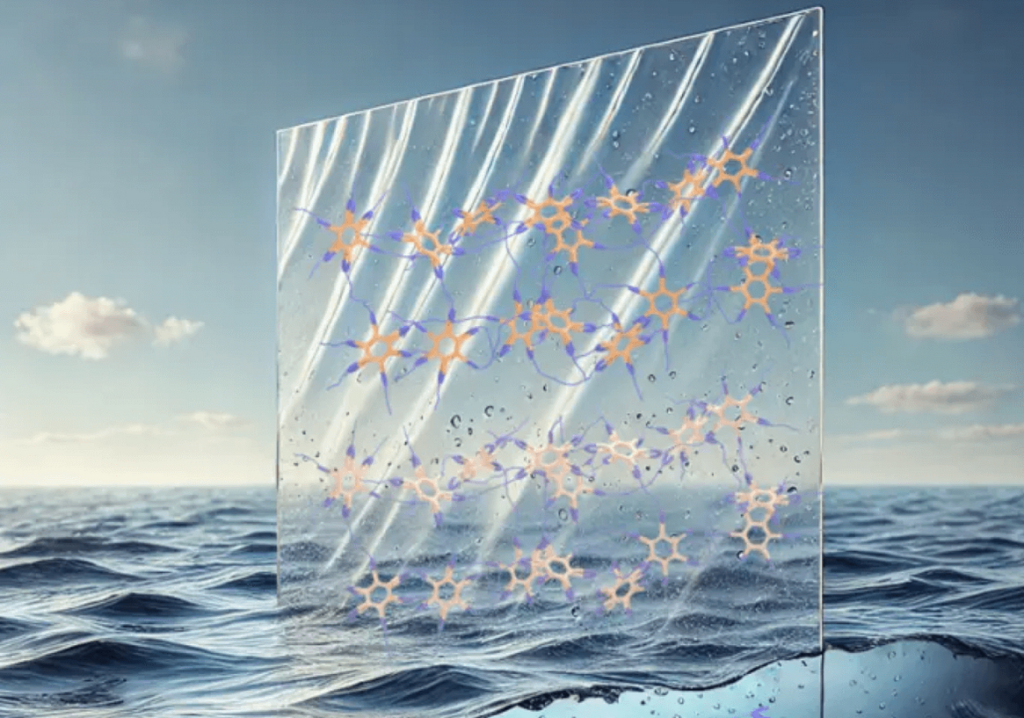Microplastics crisis solved? Scientists create plastic that vanishes in seawater
 By StudyFinds
By StudyFinds
In a world drowning in plastic waste, scientists have achieved what once seemed impossible: they’ve created a plastic that’s as strong as conventional materials but dissolves completely in seawater. This revolutionary material, developed by researchers at the RIKEN Center for Emergent Matter Science (CEMS), could help solve one of our planet’s most pressing environmental challenges — the accumulation of microplastics in our oceans.
The new plastic isn’t just another biodegradable material that breaks down into smaller pieces. Instead, it completely dissociates into its building blocks when exposed to salt water, leaving behind components that marine bacteria can metabolize. Think of it like a sophisticated sugar cube – while a regular plastic might be like a rock that only breaks into smaller rocks, this new material dissolves like sugar in water, leaving nothing harmful behind.
What makes this discovery particularly exciting is that the new plastic doesn’t sacrifice strength for sustainability. The research team created materials that are actually stronger than many conventional plastics, with some versions being as hard as traditional epoxy resins. They’re clear, durable, and can be reshaped with heat just like regular thermoplastics. One version even proved to be fireproof, adding an extra layer of practical value.
“While the reversible nature of the bonds in supramolecular plastics have been thought to make them weak and unstable,” says lead researcher Takuzo Aida in a statement. “Our new materials are just the opposite.”
According to the journal Science, the secret behind this remarkable material lies in its unique chemistry. Unlike traditional plastics that are held together by strong chemical bonds that never naturally break apart, these new plastics are constructed using what scientists call “salt bridges” – reversible connections that can be broken apart by salt water. Imagine a sophisticated set of LEGO blocks that stay firmly connected until exposed to a specific trigger that makes them cleanly separate.
The researchers used two main ingredients: a ring-shaped phosphate compound (sodium hexametaphosphate) that’s already commonly used in food additives and soil treatments, and various guanidinium-based compounds, some derived from natural sources. When mixed in water, these components undergo a fascinating process called liquid-liquid phase separation – similar to how oil and water separate, but more complex.
This separation process is crucial to the material’s success. During manufacturing, the unwanted salt components are naturally expelled, leaving behind a concentrated liquid that can be dried into a solid plastic. The resulting material is stable in regular water but falls apart when exposed to salt water, as the salt disrupts the bridges holding the structure together.
The team demonstrated the plastic’s practical potential in several ways. They created everything from thin films to three-dimensional printed objects. They even showed how the material could be used as a strong adhesive underwater. When they wanted to make the plastic more resistant to water, they simply added a thin protective coating that allowed the material to maintain its shape while submerged.
Perhaps most impressively, the researchers developed a version using chondroitin sulfate, a natural polysaccharide commonly found in cartilage. This variant proved even stronger than the original versions, demonstrating that sustainable plastics can be made from biological materials without compromising performance.
In durability tests, the plastics showed impressive results. They remained stable at temperatures up to about 300°C (572°F) and displayed strength characteristics that matched or exceeded many conventional plastics. Yet when exposed to soil conditions, they degraded much faster than traditional biodegradable plastics like polylactic acid (PLA).
The material also offers a perfect solution for recycling. When immersed in salt water, it breaks down into its original components, which can be easily separated and reused to make new plastic. This creates a truly circular economy where nothing goes to waste.
Just like their dissolving creation, the implications of this research are crystal clear: we may finally have a path to plastic products that serve their purpose without leaving a permanent mark on our planet. It’s a solution that, much like the material itself, elegantly disappears when its job is done.
Methodology
The researchers created their sustainable plastics through a water-based process combining two types of ionic compounds. They mixed solutions of sodium hexametaphosphate with various guanidinium-based compounds, which underwent liquid-liquid phase separation.
This natural separation process expelled unwanted salts and created a concentrated phase that could be dried into solid plastic. They tested multiple variations of the guanidinium compounds and also created versions using chondroitin sulfate as the anionic component. The materials underwent extensive physical testing, including mechanical strength measurements, thermal analysis, and degradation studies.
Key Results
The created plastics demonstrated remarkable properties: densities around 1.6 g/cm³, high optical transparency (97%), and impressive mechanical strength with Young’s moduli ranging from 8.7 to 18.0 GPa. The materials showed thermal stability up to about 300°C and could be reshaped above their glass transition temperatures.
When exposed to saltwater, they completely dissociated into their component parts, which could be recovered at yields above 80%. The chondroitin sulfate versions showed even higher tensile strengths, reaching up to 94 MPa.
Study Limitations
The materials showed sensitivity to water, particularly salt water, which while beneficial for environmental degradation, could limit some applications. The researchers addressed this by using protective coatings like parylene C. The study didn’t include long-term durability testing under various environmental conditions, and scale-up considerations for manufacturing weren’t fully explored. The economic viability of large-scale production wasn’t addressed in detail.
Discussion & Takeaways
This research demonstrates a new approach to creating sustainable plastics that combines practical durability with environmental degradability. The materials’ ability to completely dissociate in salt water, rather than just fragmenting into microplastics, represents a significant advance in addressing marine plastic pollution. The successful incorporation of biological materials like chondroitin sulfate suggests the potential for further development using other natural polymers. The materials’ thermal reshaping capability and recyclability offer practical advantages for manufacturing and end-of-life handling.
Funding & Disclosures
The research was supported by a JSPS Grant-in-Aid for Specially Promoted Research and RIKEN Strategic Partnership Collaborative Project with Eindhoven University of Technology. Several authors are inventors on a patent application related to this work. The study received additional support from Kao Corporation and various research fellowships. The authors declared no other competing interests.
Source: StudyFinds
StudyFinds sets out to find new research that speaks to mass audiences — without all the scientific jargon. The stories we publish are digestible, summarized versions of research that are intended to inform the reader as well as stir civil, educated debate. StudyFinds Staff articles are AI assisted, but always thoroughly reviewed and edited by a Study Finds staff member. Read our AI Policy for more information.
Image: Artistic rendering of the new plastic. Cross linked salt bridges visible in the plastic outside the seawater give it its structure and strength. In seawater (and in soil, not depicted), resalting destroys the bridges, preventing microplastic formation and allowing the plastic to become biodegradable. (Credit: RIKEN)
Source: https://naturalblaze.com/2024/11/microplastics-crisis-solved-scientists-create-plastic-that-vanishes-in-seawater.html
Anyone can join.
Anyone can contribute.
Anyone can become informed about their world.
"United We Stand" Click Here To Create Your Personal Citizen Journalist Account Today, Be Sure To Invite Your Friends.
Before It’s News® is a community of individuals who report on what’s going on around them, from all around the world. Anyone can join. Anyone can contribute. Anyone can become informed about their world. "United We Stand" Click Here To Create Your Personal Citizen Journalist Account Today, Be Sure To Invite Your Friends.
LION'S MANE PRODUCT
Try Our Lion’s Mane WHOLE MIND Nootropic Blend 60 Capsules
Mushrooms are having a moment. One fabulous fungus in particular, lion’s mane, may help improve memory, depression and anxiety symptoms. They are also an excellent source of nutrients that show promise as a therapy for dementia, and other neurodegenerative diseases. If you’re living with anxiety or depression, you may be curious about all the therapy options out there — including the natural ones.Our Lion’s Mane WHOLE MIND Nootropic Blend has been formulated to utilize the potency of Lion’s mane but also include the benefits of four other Highly Beneficial Mushrooms. Synergistically, they work together to Build your health through improving cognitive function and immunity regardless of your age. Our Nootropic not only improves your Cognitive Function and Activates your Immune System, but it benefits growth of Essential Gut Flora, further enhancing your Vitality.
Our Formula includes: Lion’s Mane Mushrooms which Increase Brain Power through nerve growth, lessen anxiety, reduce depression, and improve concentration. Its an excellent adaptogen, promotes sleep and improves immunity. Shiitake Mushrooms which Fight cancer cells and infectious disease, boost the immune system, promotes brain function, and serves as a source of B vitamins. Maitake Mushrooms which regulate blood sugar levels of diabetics, reduce hypertension and boosts the immune system. Reishi Mushrooms which Fight inflammation, liver disease, fatigue, tumor growth and cancer. They Improve skin disorders and soothes digestive problems, stomach ulcers and leaky gut syndrome. Chaga Mushrooms which have anti-aging effects, boost immune function, improve stamina and athletic performance, even act as a natural aphrodisiac, fighting diabetes and improving liver function. Try Our Lion’s Mane WHOLE MIND Nootropic Blend 60 Capsules Today. Be 100% Satisfied or Receive a Full Money Back Guarantee. Order Yours Today by Following This Link.







